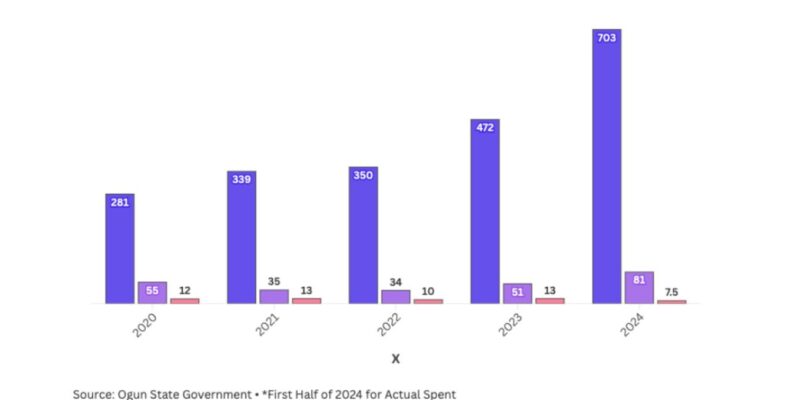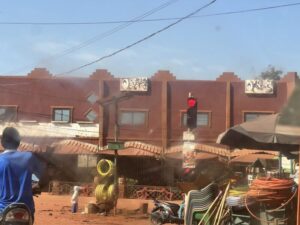One of the places this is evident is Ogun State, where a consistent underfunding of the health sector has led to alarming and tragic circumstances, resulting in the loss of numerous lives particularly vulnerable mothers and children mostly in rural communities.
The healthcare system in Nigeria faces significant challenges due to inadequate funding, which is affecting infrastructure and service delivery. One of the places this is evident is Ogun State, where a consistent underfunding of the health sector has led to alarming and tragic circumstances, resulting in the loss of numerous lives particularly vulnerable mothers and children mostly in rural communities. Oyetunde Tobi reports that the underfunding of healthcare in Ogun State is not merely a statistical concern as it is having great implications for the health and well-being of its population.
A resident of Sango, Ogun State, who only identified herself as Mrs Arifalo, narrated how she lost a son at the state general hospital due to the absence of oxygen to revive her son.
“My son was sick for days, and I took him to the General Hospital in Sango, he was being treated, and one day, he was breathing heavily and gasping for air. He died because they said there was no oxygen to help him breathe,” she narrated as she struggled to hold back tears.
Some residents who also spoke with this reporter corroborated her claims as they shared their different experiences while calling on the state government to focus on investing in delivering quality healthcare.
Mr Ikulayo Babatope, who lives in Nntabo, Ado-Odo-Ota Local Government Area, LGA, complained of how successive governments have refused to build a hospital for residents of the community.
He said residents are left with either visiting expensive private hospitals or traditional medical centres for healthcare.
“The only hospital we have here was built by the Community Development Association (CDA). We built it and employed people that we are paying by ourselves. We informed the government about it when we were building and they sent representatives to come and commission it when we finished building but we have been maintaining it and paying for the three workers there.
“Before we built the hospital, we either went to the general hospital, which is about 30 minutes’ drive, or we went to private hospitals. But they are expensive, and we don’t have the money. Or we visited traditional health centres for herbs,” he explained.
Mrs Taiwo (not real name), who lives in Odeda area of the state, lamented that the closest public health facility to her community is not well-equipped. She added that aside from having a few workers, they are asked to pay for every drug and injection.
She said, “As a pregnant woman, when we go to register for ante-natal, they don’t give us all the drugs we need and even injections. We pay before we get injections and drugs after paying for registration. We pay more money and receive less treatment unlike before.”
“The beds in the hospital are not good, so when we go for treatment, we prefer to go home instead of being admitted to stay,” she added.
Mrs Ibinabo Dixon, a resident of Arepo, a border community between Ogun and Lagos states, lamented the absence of any healthcare facility in the area. She lamented that residents have to either seek medical care at private hospitals, travel to neighbouring communities, or travel to Lagos for medical attention.
She added that the state governor had promised to build a health facility in the community but nothing has been done despite the community donating plots of land for the construction.
“Those who can afford it go to private hospitals, while those who cannot afford that will either go to a health centre in Magboro or go to Ojodu, Lagos, where they have a primary health centre. In times of medical emergencies, one always has few minutes to get medical attention or lives will be lost
“In 2022, when Governor Abiodun came to open the Arepo Road, he was shown a piece of land where he promised to build a primary health centre but we have not heard anything from him yet. We are doing a lot of advocacies to reach the government to redeem their pledge and we definitely need a health centre in Arepo,” she said.
A 2023 data by the National Population Commission (NPC) shows that Ogun State recorded 7,211 deaths between January and June 2023 with fever/typhoid listed as the most common cause of death.
According to the Multiple Indicator Cluster Survey (MICS) carried out by the National Bureau of Statistics (NBS) together with the United Nations Children’s Fund (UNICEF), Gavi, the Vaccine Alliance, and Bill & Melinda Gates Foundation (BMGF) and released in August 2022, Ogun State ranks the highest in the deaths of children between 0 – 5years with the record of 85 deaths out of 1,000 children and also the lowest in the care for children after birth with the estimation of 77 per cent. The survey also showed that Ogun State recorded the lowest number of hospital visits to seek healthcare for fever in South West.
Deviation of Health Budget in Ogun State
In April 2001, African Union members committed to allocating 15% of the government budget to the health sector to address health challenges on the continent. Only a handful of countries and states meet this target yearly. Ogun State last met the target in 2020 when it allocated 19% of the state’s budget to the health sector.
However, successive administrations in Ogun State have created a pattern of underspending yearly budgetary allocations to the health sector, thereby creating significant implications for the overall healthcare delivery in the state.
Historically, the health budget in the state has faced challenges such as underspending and misallocation of resources, thus, leading to gaps in healthcare delivery, particularly in rural and underserved areas. In those areas, health seekers are constrained to receiving care in dilapidated hospitals with minimal services or seekingalternative means.
A detailed look at the health budget of the state from 2020 to the first half of 2024 shows that about 21.5% of budgetary allocation for health was actually spent leaving a whooping 78.5% of the health budget unspent. Noteworthy, a huge part of the budget is spent on recurrent expenditure particularly payment of salaries and benefits while capital expenditures are grossly insufficient.

Source 一 Ogun State 2023 – 2025 Medium Term Expenditure Framework
Additionally, in 2020, Ogun State’s budget for the fiscal year was N281 billion, out of which N55bn (19.6%)was earmarked for the health sector. At the end of the fiscal year, only N12bn (21.8% of health budget) was spent, with N10bn used as salaries and benefits.
The same pattern has been recorded from 2020 to 2024, as shown in the graph below. In 2021, N35bn (10.3%) was budgeted for healthcare out of N339bn total budget of the state. Of the N35bn, N13bn (37% of health budget) was spent leaving a balance of 22bn. Also, priority was given to recurrent expenditure as N11.5bn was spent on salaries and benefits while N1.5bn was devoted to capital expenditure.
In 2022, out of the N350bn budget of the state, N34bn (9.8%) was budgeted for health. However, only N10bn (29.41% of the health budget) was spent, leaving a balance of 24bn. Also, recurrent expenditure took a significant portion of the funds, with N9bn spent on overhead and personnel costs and N1bn used for healthcare service development in capital expenditure.
The trend continued in 2023 as N51bn (10.9%) was budgeted for health out of the total budget of N472bn. From the total amount budgeted for health, N13bn (25.5% of the health budget) was spent, leaving a balance of 38bn. From the N13bn, only N1.4bn was spent on capital projects, while N11.6bn was used to cater for overhead and personnel cost.
Similarly, in 2024, out of the N703bn budget of the state, N81.5bn (12%) was budgeted for health, and N7.5bn (9.2% of the health budget) has so far been spent in the first half of 2024. N7.3bn was spent on overhead and personnel costs.
The expenditure shows a trend of underspending the health budget and a misplaced priority of focusing on paying salaries alone rather than investing in providing quality healthcare for the people of Ogun State.

Health Centres Not Properly Furnished
According to the Minimum Standard for Primary Health Care in Nigeria designed by the National Primary Health Care Development Agency (NPHCDA), every Primary health care centre must have at least 13 rooms including two delivery rooms, two consulting rooms, an in-patient room, and toilet facilities (male and female). The PHC must also have a clean water source from a motorized borehole, with 19 medical personnel and five support staff.
Despite the NPHCDA’s mandatory staffing standards,numerous health centres in Ogun State are not meeting these requirements, thereby leading to poor health service delivery.
A clear example of this can be seen at Iwoye Primary Health Centre located in Yewa South LGA. Aside from not having enough rooms, the PHC also does not have access to clean water. Staff and patients depend on water from a well behind the health centre.

Speaking of the frightful condition of Iwoye PHC, a civil servant in the state, who spoke on condition of anonymity due to fear of victimization, said the health centre does not only lack enough drugs but also lacksmedical equipment and other necessities like beds and toilet for staff and patients.
“There are no toilets and our wards are very bad. The government needs to employ more nurses and health workers to attend to people. We have not seen anything that the government is doing in Iwoye facility,” he said.

The situation is not so different at Orile-Ilugun PHCsituated in Odeda where staff and patients also depend on well water as their only source of water.
Despite being short-staffed, heath-seekers also complained of having no beds to use during treatment as well as not being given enough drugs when being treated as they often resort to buying drugs from nearby pharmacies.

“In our facility, there are no beds for us to use when we visit and not enough instruments. Some of the things at the health centre are not working again, they don’t have machine to check our blood pressure, they just touch us and write any number that they want,” a health seeker in Odeda said.
Mr Ishola, a community leader in Odeda, who corroborated the claim said, “We don’t have a good government in Ogun State. In the health facility in our community, there is no modern equipment and no bed for people to use when admitted. Even drugs and injections are being managed for people that go for treatment.”
At Emuren PHC located in Sagamu LA, there is only one government-employed nurse while the community employed two ad-hoc staff to assist the nurse and is responsible for paying these workers for attending to residents.
One of the community leaders lamented the worrying situation in the PHC as he appealed to the government to invest in the health sector in the state.
“We only have one nurse in the health centre and two support staff members but it is the community that is paying the ad-hoc staff so that they can assist the only nurse for fast treatment of people.
“We don’t have drugs in the facility, we don’t even have drugs that can be used to relieve pain. We prescribe the drugs to people for them to get outside the health centre. Government is supposed to spend more money on health facilities in our community because we also don’t have some of these modern equipment being used in other places,” he said.
Medical Association Tasks Government To Invest More In Health Sector
The National Association of Nigeria Nurses and Midwives (NANNM) urged Governor Dapo Abiodun’s administration to increase budgetary allocation to the health sector while ensuring there is an improvement in the health infrastructure in the state.
Speaking for the association, Mr Fashina Olusina, Public Relations Officer and Acting Secretary of NANNM, lamented the current state of healthcare in the state noting that the government is performing below par in the health sector.
“Obviously this government, not only the state government, the Nigerian government in totality, the federal government and the state government are not spending enough. The budgetary allocation recommendation for health is supposed to be 15% of the annual budgetary allocation but as it is now, we are doing far less than that and that has left so much gap, including affecting the health infrastructure we have in the state.
“There are some specific health infrastructures that are not available for diagnostic and for case managementand this of course is affecting healthcare delivery in the state,” Mr Olusina said.
The PRO of NANNM lamented that Ogun State residents sometimes go outside the state to access health services while some opt for treatment in privatelyowned hospitals due to the worrying conditions of public hospitals.
He added that though the government is trying to improve the structure of some hospitals, more still needs to be done in providing quality healthcare to residents of the state.
“There is a need to balance the recurrent and the capital expenditure in the healthcare sector and for the government to dedicate more and more of the resources of the state to healthcare.
“In reality, the state government has improved on the structure of some infrastructure in the hospital setting, however, it is not enough. There is a need for more to be done in this state.
“We want the government to visit dilapidated health facilities, both state-owned and the primary health centres in the state. There are quite a number of them that need face-lifting. We also want the government to purchase modern equipment, MRI, dialysis machines and all this that will make us provide health service to our people. So, the government can do more to improve this infrastructure so that our people will enjoy health care services right here in Ogun State,” he said.
Government Keeps Mum
Dr Tomi Coker, Ogun State Commissioner for Health, refused to respond to multiple calls and messages sent to her for over two weeks requesting her response to the findings in this report. The Special (Technical) Assistant to Dr Coker, Dr Olumuyiwa Odugbesan, said the commissioner was not available to respond to the findings of this report.
He, however, asked for questions to be sent to him to see if he could get the commissioner to respond, but no response was received after the questions were sent to him.
Similarly, Dr Elijah Ogunsola, Executive Secretary of the Primary Health Care Development Board, declined to respond to inquiries on the conditions of PHC in Ogun State.
He initially answered his call and promised to call back as he was in a meeting but did not call back and also did not answer subsequent calls.
After two weeks of not responding to calls and messages, a letter was sent to Dr Ogunsola’s office. The letter, which was sent on the 17th of October, 2024,again informed him of the findings in this report and requested a response, but no feedback was gotten from him.
In further attempts to get a response from the government, Mr Lekan Adeniran, Chief Press Secretaryto the Governor and Dr Lateef Lawal, Special Adviser on Health to the Governor, were contacted but they both directed that enquiries should be sent to the Commissioner for Health, saying she is in the best position to comment on the findings.
However, in January 2024, the Ogun State Government through the Commissioner for Health said the state government would rehabilitate 472 PHCs in Governor Dapo Abiodun’s second tenure to consolidate the administration’s gain in the health sector.
Similarly, in July 2024, Dr Coker announced that the state government had launched the first round of the 2024 Optimised Maternal, Newborn and Child Health Week (OMNCHW) as part of its ongoing efforts to improve maternal and child health in the state. The initiative aims to provide women access to antenatal care, improve early detection and management of childhood illnesses, and strengthen routine immunization, among other objectives.
*This report was facilitated by the African Centre for Development Journalism ACDJ as part of its 2024 inequalities Reporting Fellowship Supported by MacArthur Foundation through the Wole Soyinka Centre for Investigative Journalism.



